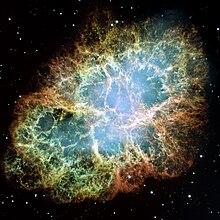
Back مستعر أعظم قريب من الأرض Arabic ابرنواختر نزدیک زمین Persian Supernova dekat Bumi ID Supernova vicina alla Terra Italian 近地球超新星 Japanese 근지구 초신성 Korean Supernovă din apropierea Pământului Romanian Околоземная сверхновая Russian Dünya'ya yakın süpernova Turkish Навколоземна наднова Ukrainian

A near-Earth supernova is an explosion resulting from the death of a star that occurs close enough to the Earth (roughly less than 10 to 300 parsecs [30 to 1000 light-years] away[2]) to have noticeable effects on Earth's biosphere.
An estimated 20 supernova explosions have happened within 300 pc of the Earth over the last 11 million years. Type II supernova explosions are expected to occur in active star-forming regions, with 12 such OB associations being located within 650 pc of the Earth. At present, there are six near-Earth supernova candidates within 300 pc.[3]
- ^ Kaplan, D. L.; Chatterjee, S.; Gaensler, B. M.; Anderson, J. (2008). "A Precise Proper Motion for the Crab Pulsar, and the Difficulty of Testing Spin-Kick Alignment for Young Neutron Stars". The Astrophysical Journal. 677 (2): 1201–1215. arXiv:0801.1142. Bibcode:2008ApJ...677.1201K. doi:10.1086/529026. S2CID 17840947.
- ^ Joshua Sokol (Jan 14, 2016). "What If History's Brightest Supernova Exploded In Earth's Backyard?". The Atlantic.
- ^ Firestone, R. B. (July 2014). "Observation of 23 Supernovae That Exploded <300 pc from Earth during the past 300 kyr". The Astrophysical Journal. 789 (1): 11. Bibcode:2014ApJ...789...29F. doi:10.1088/0004-637X/789/1/29. 29.
© MMXXIII Rich X Search. We shall prevail. All rights reserved. Rich X Search